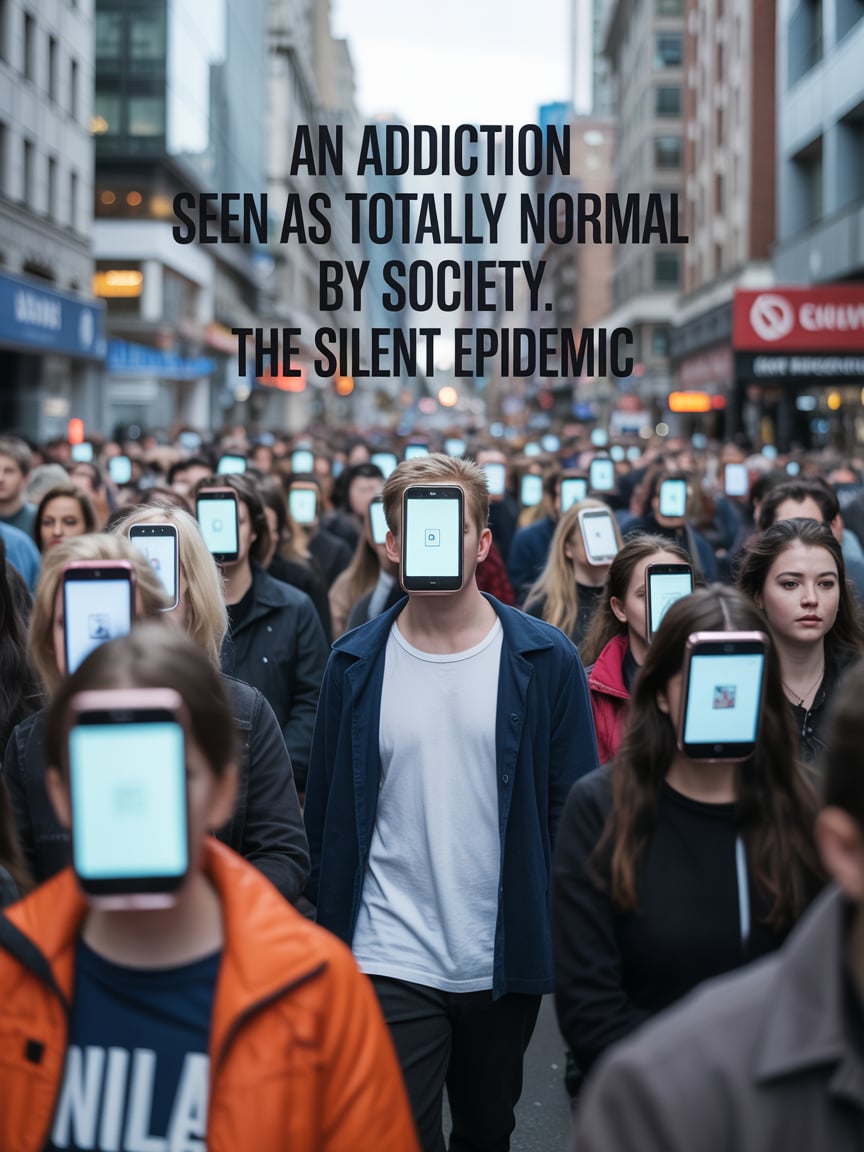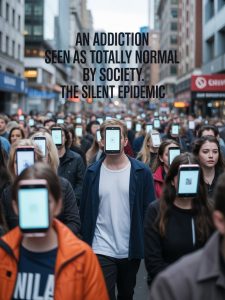An Addiction Seen as Totally Normal by Society: The Silent Epidemic


Introduction
In modern society, the concept of addiction typically evokes images of drugs, alcohol, gambling, or other universally acknowledged vices. These forms of addiction are commonly recognized as harmful, often leading to interventions, treatment plans, and public awareness campaigns. However, a subtler, more insidious form of addiction exists—one that is deeply embedded in our culture and accepted, even celebrated, as normal. This addiction is to technology, particularly smartphones and social media, and it is silently shaping our behaviors, relationships, and mental health in profound ways. This article explores the normalization of this addiction, its societal implications, and what we can do to reclaim balance in our lives.
Defining Addiction in a Modern Context
Addiction, at its core, is a condition characterized by compulsive engagement in a behavior despite adverse consequences. Traditionally, this has been associated with substance abuse. But behavioral addictions are increasingly gaining recognition, particularly those tied to digital technologies. The Diagnostic and Statistical Manual of Mental Disorders (DSM-5) now includes criteria for Internet Gaming Disorder, signifying a growing acknowledgment of non-substance-related addictions. Yet, even as awareness grows, the use of smartphones, social media platforms, and constant connectivity is rarely scrutinized with the same urgency.
The Normalization of Digital Dependency
Consider the average day of a modern individual: the first action upon waking is often checking a phone; social interactions are punctuated by screen time; meals are eaten while scrolling; even moments of rest are interrupted by notifications. In many professional environments, being constantly available via email or messaging apps is not just expected, but rewarded. Social media influencers, content creators, and tech companies encourage continuous engagement, feeding the cycle of dependency. The line between use and addiction is blurred, and the behavior is validated by its ubiquity.
The Role of Technology Companies
A significant reason for the normalization of this addiction is the deliberate design choices made by technology companies. Platforms like Facebook, Instagram, TikTok, and Twitter are engineered to be addictive. Features such as infinite scroll, push notifications, likes, and algorithmic content curation exploit psychological principles like variable rewards and social validation to keep users engaged for as long as possible. This isn’t accidental; it’s a business model based on attention and data. The more time users spend on these platforms, the more profitable they become. As a result, addiction is not just normalized—it’s incentivized.
Impact on Mental Health
Numerous studies have linked excessive screen time and social media use to a range of mental health issues, including anxiety, depression, low self-esteem, and loneliness. The curated nature of social media content can lead to unrealistic comparisons, fostering feelings of inadequacy and discontent. Moreover, the dopamine-driven feedback loops created by likes, shares, and comments mimic the mechanisms of more traditionally recognized addictions. Yet, because these platforms are integrated into daily life and seen as essential for communication, work, and entertainment, the harmful effects are often dismissed or overlooked.
Erosion of Deep Human Connection
One of the most troubling aspects of normalized digital addiction is its impact on interpersonal relationships. While social media purports to connect us, it often leads to shallow interactions and disconnection in real-world relationships. The constant distraction of devices during conversations undermines the quality of those interactions, leading to a decline in empathy and active listening. Children growing up in digitally saturated environments may struggle with developing emotional intelligence and face-to-face social skills, posing long-term implications for societal cohesion.
Cultural Reinforcement and the Fear of Missing Out
The normalization of digital addiction is reinforced by cultural narratives that equate constant connectivity with success, relevance, and social belonging. The “fear of missing out” (FOMO) drives individuals to stay online, lest they fall behind in news, trends, or social interactions. In turn, this pressure perpetuates the cycle of addiction. Social norms around technology use, such as bringing phones to social gatherings or checking notifications during meetings, further entrench this behavior as acceptable and even expected.
The Role of Education and Awareness
To counteract the normalization of digital addiction, education and awareness are crucial. This includes integrating digital literacy into school curricula, promoting healthy screen habits, and encouraging critical thinking about media consumption. Parents and educators must model balanced technology use and provide children with opportunities for offline play and interaction. Public health campaigns, similar to those used for smoking or alcohol awareness, could be instrumental in highlighting the risks of excessive digital engagement.
Policy and Regulation
Governments and regulatory bodies also have a role to play in addressing this issue. This could involve enforcing transparency in algorithm design, limiting the use of manipulative features like autoplay or infinite scroll, and implementing age-appropriate safeguards for young users. Additionally, workplace policies that encourage digital detoxes or restrict after-hours communication could help shift cultural expectations around constant availability.
Personal Responsibility and Mindful Usage
While systemic change is essential, individual responsibility cannot be overlooked. Practicing digital mindfulness—being intentional and aware of how and why we use technology—can help mitigate the negative effects of digital addiction. Strategies such as setting screen time limits, using grayscale mode, turning off non-essential notifications, and designating tech-free zones or times can foster healthier habits. Regular digital detoxes, even if brief, can restore a sense of control and balance.
Embracing Alternatives
Fighting normalized addiction also means re-investing in activities that promote genuine fulfillment and connection. This includes spending time in nature, engaging in creative pursuits, practicing mindfulness or meditation, and nurturing face-to-face relationships. These alternatives not only provide a break from screens but also reinforce a sense of presence and well-being that digital interactions often fail to deliver.
Conclusion
The addiction to technology and digital content is one of the most widespread yet underrecognized challenges of our time. Its normalization by society masks the very real and pervasive consequences it has on our mental health, relationships, and collective well-being. By acknowledging it as a legitimate form of addiction, we can begin to foster healthier relationships with technology. Through a combination of awareness, education, policy, and personal responsibility, we can reclaim our time, attention, and human connection from the grasp of devices. Living with grace in a complex world may very well begin with turning off our screens and turning toward each other.














